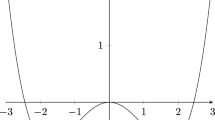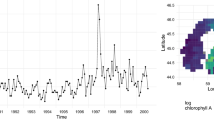Abstract
We consider a dynamic stress–strength model under external shocks. The strength of the system decreases with time and the failure occurs when the strength finally vanishes. Furthermore, there is another cause of the system failure induced by an external shock process. Each shock is characterized by the corresponding stress. If the magnitude of the stress exceeds the current strength, then the system also fails. We assume that the initial strength of the system and its decreasing drift pattern are random. We derive the survival function of the system and interpret the time-dependent dynamic changes of the random quantities which govern the reliability performance of the system.
Similar content being viewed by others
References
Barlow RE, Proschan F (1975) Statistical theory of reliability and life testing. Holt Rinehart and Winston, New York
Beichelt FE, Fischer K (1980) General failure model applied to preventive maintenance policies. IEEE Trans Reliab 29:39–41
Block HW, Borges W, Savits TH (1985) Age-dependent minimal repair. J Appl Probab 22:370–386
Cha JH, Finkelstein M (2009) On a terminating shock process with independent wear increments. J Appl Probab 46:353–362
Cha JH, Finkelstein M (2011) On new classes of extreme shock models and some generalizations. J Appl Probab 48:258–270
Cha JH, Finkelstein M (2012) Information-based thinning of point processes and its application to shocks models. J Stat Plan Inference 142:2345–2350
Finkelstein M (2008) Failure rate modelling for reliability and risk. Springer, London
Finkelstein M, Cha JH (2013) Stochastic modeling for reliability: shocks, burn-in and heterogeneous population. Springer, London
Fleming TR, Harrington DP (1991) Counting processes and survival analysis. Wiley, New York
Li T, Anderson JJ (2013) Shaping human mortality patterns through intrinsic and extrinsic vitality processes. Demogr Res 28:342–368
Marshall AW, Olkin I (1979) Inequalities: theory of majorization and its applications. Academic Press, New York
Marshall AW, Shaked M (1979) Multivariate shock models for distributions with increasing hazard rate average. Ann Probab 7:343–358
Savits TH, Shaked M (1981) Shock models and the MIFRA property. Stat Process Appl 11:273–283
Mori Y, Ellingwood BR (1994) Maintaining: reliability of concrete structures. I: role of inspection/repair. J Struct Eng 120:824–845
Shaked M, Shanthikumar J (2007) Stochastic orders. Springer, New York
Strehler BL, Mildvan AS (1960) General theory of mortality and aging. Science 132:14–21
van Noortwijk JM, van der Weide JAM, Kallen MJ, Pandey MD (2007) Gamma processes and peaks-over-threshold distributions for time-dependent reliability. Reliab Eng Syst Saf 92:1651–1658
van Noortwijk JM (2009) A survey of the application of gamma processes in maintenance. Reliab Eng Syst Saf 94:2–21
Wenocur ML (1989) A reliability model based on the gamma process and its analytic theory. Adv Appl Probab 21:899–918
Acknowledgments
The authors would like to thank the editor and the referee for very careful and helpful comments, which have improved and clarified the presentation of our paper. The work of the first author was supported by the National Research Foundation of Korea (NRF) Grant funded by the Korea government (MEST) (No. 2011-0017338). The work of the first author was also supported by Priority Research Centers Program through the National Research Foundation of Korea (NRF) funded by the Ministry of Education, Science and Technology (2009-0093827). The work of the second author was supported by the NRF (National Research Foundation of South Africa) Grant FA2006040700002.
Author information
Authors and Affiliations
Corresponding author
Appendices
Appendix 1
Substituting a random \(R\) instead of its realization \(r\) into (6) and applying the operation of conditional expectation,
where, as follows from
and
Thus the conditional density of strength is given by
Observe that, for \(t_1<t_2\),
which is decreasing in \(r\). Thus, \((R|T_S>t_1) \le _{fr} (R|T_S>t_2)\), which also implies \((R|T_S>t_1) \le _{st} (R|T_S>t_2)\). As \({\bar{M}}(r)\) is decreasing function of \(r\), we have
Thus \({\tilde{p}}(t)\) is decreasing.
Alternatively, obtaining the derivative of the function \({\tilde{p}}(t)\) defined in (8) with respect to \(t\), it is easy to see that
where expectation is with respect to the pdf (19).
Appendix 2 (Proof of Theorem 1)
The unconditional survival function can be obtained by taking expectation of the conditional survival function in (9) with respect to all random quantities in the conditional part. This procedure will be performed sequentially.
First, we take expectation of
with respect to the conditional distribution of \((S_1,S_2,\ldots ,S_{N(t)}|N(s),0\le s\le t;R=r,V=v)\) to obtain \(P(T_S>t|N(s),0\le s\le t;R=r,V=v)\). However, due to independence assumption,
and thus,
Again, due to the independence assumption, \(P(T_S>t|R=r,V=v)\) can be obtained by taking expectation of \(P(T_S>t|N(s),0\le s\le t;R=r,V=v)\) with respect to the shock process \(\{N(s),0\le s \le t\}=\{T_1,T_2,\ldots ,T_{N(t)}, N(t)\}\):
It is well known that the joint distribution of \(T_1,T_2,\ldots ,T_n\) given \(N(t)=n\) is the same as the joint distribution of order statistics \(T_{(1)}'\le T_{(2)}'\le \cdots \le T_{(n)}'\) of i.i.d. random variables \(T_1',T_2',\ldots ,T_{n}'\), where the pdf of the common distribution of \(T_j'\)’s is given by \(\lambda (x)/\varLambda (t)\), \(0 \le x \le t\), \(\varLambda (t)\equiv \int _{0}^{t}\lambda (u)du\). Therefore, it can be easily verified that
Finally, the unconditional survival function can be obtained by taking expectation of \(P(T_S>t|R=r,V=v)\) in (22) with respect to the joint distribution of \((R,V)\):
By applying Leibniz rule, the failure rate function of a system \(\lambda _S(t)\) is
Rights and permissions
About this article
Cite this article
Cha, J.H., Finkelstein, M. A dynamic stress–strength model with stochastically decreasing strength. Metrika 78, 807–827 (2015). https://doi.org/10.1007/s00184-015-0528-x
Received:
Published:
Issue Date:
DOI: https://doi.org/10.1007/s00184-015-0528-x




